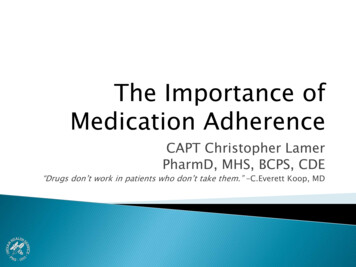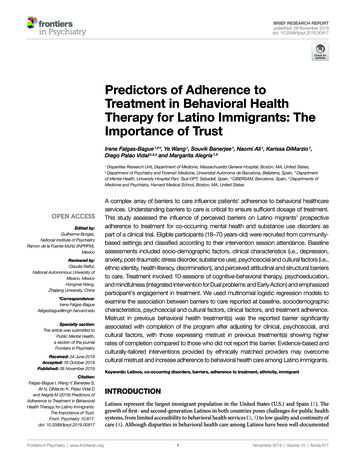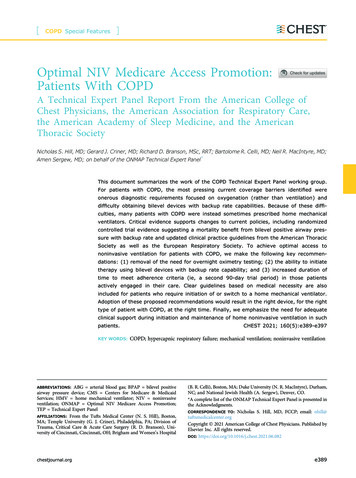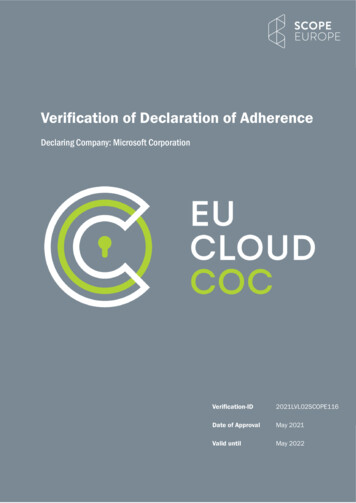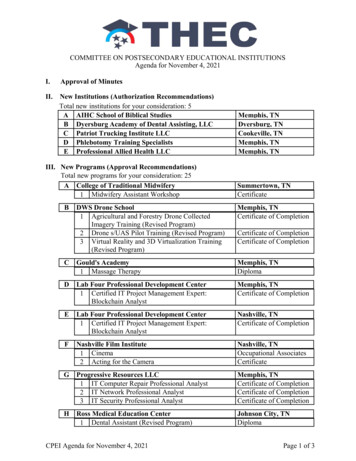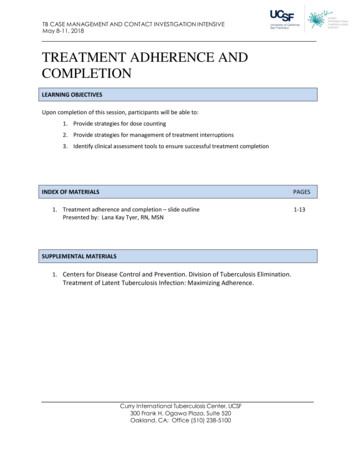
Transcription
TB CASE MANAGEMENT AND CONTACT INVESTIGATION INTENSIVEMay 8-11, 2018TREATMENT ADHERENCE ANDCOMPLETIONLEARNING OBJECTIVESUpon completion of this session, participants will be able to:1. Provide strategies for dose counting2. Provide strategies for management of treatment interruptions3. Identify clinical assessment tools to ensure successful treatment completionINDEX OF MATERIALSPAGES1. Treatment adherence and completion – slide outlinePresented by: Lana Kay Tyer, RN, MSNSUPPLEMENTAL MATERIALS1. Centers for Disease Control and Prevention. Division of Tuberculosis Elimination.Treatment of Latent Tuberculosis Infection: Maximizing Adherence.Curry International Tuberculosis Center, UCSF300 Frank H. Ogawa Plaza, Suite 520Oakland, CA; Office (510) 238-51001-13
TB CASE MANAGEMENT AND CONTACT INVESTIGATION INTENSIVEMay 8-11, 2018ADDITIONAL REFERENCES Nahid P, Dorman SE, Alipanah N, et al. Official American Thoracic Society/Centers for DiseaseControl and Prevention/Infectious Diseases Society of America Clinical Practice Guidelines:Treatment of Drug-Susceptible Tuberculosis. Clin Infect Dis. 2016;1-49. Curry International Tuberculosis Center and California Department of Public Health, 2016: DrugResistant Tuberculosis: A Survival Guide for Clinicians, Third Edition [203-234]. Centers for Disease Control and Prevention: NTIP User Guide. ntipuserguide.pdf Toczek A, Cox H, duCros P, Cooke G, Ford N. Strategies for reducing treatment default in drugresistant tuberculosis: systematic review and meta-analysis. Int J Tuberc Lung Dis.2013;17(3):299 -307. Lutge EE, Wiysonge CS, Knight SE, Volmink J. Material incentives and enablers in themanagement of tuberculosis. Cochrane Database of Systematic Reviews 2012, Issue 1. Art. No.:CD007952. M’Imunya JM, Kredo T, Volmink J. Patient education and counseling for promoting adherence totreatment for tuberculosis. Cochrane Database of Systematic Reviews 2012, Issue 5. Art. No.:CD006591. Mitruka K, Winston CA, Navin TR. Predictors of failure in timely tuberculosis treatmentcompletion, United States. Int J Tuberc Lung Dis. 2012 Aug;16(8):1075-82. Moonan PK, Quitugua TN, Pogoda JM et al. Does directly observed therapy (DOT) reduce drugresistant tuberculosis? BMC Public Health. 2011; 11(1):19. National Tuberculosis Controllers Association: Tuberculosis Nursing: a Comprehensive Guide toPatient Care, Second Edition. 2011. [87-106] U.S. Department of Health and Human Services Centers for Disease Control and Prevention: TheReport of a Verified Case of Tuberculosis (RVCT) Instructions and Self-Study Modules. 2009 Liu Q, Abba K, Alejandria MM, Balanag VM, Berba RP, Lansang MAD. Reminder systems and latepatient tracers in the diagnosis and management of tuberculosis. Cochrane Database ofSystematic Reviews 2008, Issue 4. Art. No.: CD006594. Munro SA, Lewin SA, Smith HJ, Engel ME, Fretheim A, Volmink J. Patient Adherence toTuberculosis Treatment: A Systematic Review of Qualitative Research. PLoS Med 2007;4(7):e238.Curry International Tuberculosis Center, UCSF300 Frank H. Ogawa Plaza, Suite 520Oakland, CA; Office (510) 238-5100
TB CASE MANAGEMENT AND CONTACT INVESTIGATION INTENSIVEMay 8-11, 2018 Blumberg HM, Burman WJ, Chaisson RE, et al. American Thoracic Society/Centers for DiseaseControl and Prevention/Infectious Diseases Society of America: treatment of tuberculosis. Am JRespir Crit Care Med. 2003;167(4):603-62. World Health Organization. Adherence to long-term therapies. Evidence for action. Geneva:World Health Organization, 2003.Curry International Tuberculosis Center, UCSF300 Frank H. Ogawa Plaza, Suite 520Oakland, CA; Office (510) 238-5100
Treatment adherence and completionTB Case Management and Contact Investigation IntensiveTreatment Adherence andCompletionLana Kay Tyer, RN MSNTB Nurse ConsultantWA State Department of HealthObjectives Practice strategies for dose counting Demonstrate strategies for management of treatment interruptions Integrate clinical assessment tools to ensure successful treatmentcompletionCurry International Tuberculosis CenterMay 8-11, 20181
Treatment adherence and completionTB Case Management and Contact Investigation IntensiveWhat is the responsibility of the casemanager? Ensure the patient adheres to appropriate andadequate treatment Ensure patient receives essential medicalevaluations, including routine clinical monitoring Ensure patients response to treatment is evaluatedregularly Serve as a source of information to patient andfamilyTreatment Adherence Define adherence vs compliance How is it demonstrated by the patient? How is it assessed?Curry International Tuberculosis CenterMay 8-11, 20182
Treatment adherence and completionTB Case Management and Contact Investigation IntensiveHow is Treatment Completion Determined? Completion of treatment Positive response to treatment Negative sputum/specimen culture Improved chest radiograph Diminished or resolved symptoms Weight gain AND total number of doses taken in recommended timeframeATS Treatment of TB GuidelineCurry International Tuberculosis CenterMay 8-11, 20183
Treatment adherence and completionTB Case Management and Contact Investigation IntensiveATS Treatment of TB Guideline Recommendation 2: We suggest using directly observed therapy(DOT) rather than self-administered therapy for routine treatment ofpatients with all forms of tuberculosis. Challenges to DOT?Which patients does your clinic have the ability tooffer DOT (in-person or electronic)? MDR-TB patientsSputum smear positive TB disease patientsSputum smear negative pulmonary TB patientsTB patients with pulmonary to and HIVExtra pulmonary TB disease patientsHousehold contacts under 5 years oldHousehold contacts with immunosuppressive conditionsMDR TB contactsOthers?Curry International Tuberculosis CenterMay 8-11, 20184
Treatment adherence and completionTB Case Management and Contact Investigation IntensiveAppropriate IntervalsTarget TimeframeNational Tuberculosis Indicators Project (NTIP) Treatment Initiation- For TB patients with positive acid-fast bacillus(AFB) sputum-smear results, increase the proportion who initiatedtreatment within 7 days of specimen collection.97% Completion of Treatment- For patients with newly diagnosed TBdisease for whom 12 months or less of treatment is indicated, increasethe proportion who complete treatment within 12 months. 95%What are reasons to extend treatment and are not included inthis measure?CDC NTIP User Guide 2015 userguide.pdfCurry International Tuberculosis CenterMay 8-11, 20185
Treatment adherence and completionTB Case Management and Contact Investigation IntensiveWhat is “Appropriate Treatment”? Drug susceptibility testing Drug-o-gramWhat is a Countable Dose? DOT & VDOT Partial doses during re-challenging Interval doses Treatment completion counted in weeksCurry International Tuberculosis CenterMay 8-11, 20186
Treatment adherence and completionTB Case Management and Contact Investigation IntensiveRVCT Manual: DOTTotal DOT vs. Both DOT and SATotal Direct Observed Both Direct ObservedTherapy (DOT)Therapy SelfAdministration (SA)Treatment 1-5x perweekTreatment 7x perweekCurry International Tuberculosis CenterMay 8-11, 2018All treatment DOTIf any treatment is SADOT at least 5x perweekSA more than 2x perweek7
Treatment adherence and completionTB Case Management and Contact Investigation IntensiveRVCT Manual: Counting weeksLapse in Treatment vs Treatment failure Timing of interruption: Intensive phase Continuation phase Earlier and longer the duration of interruption the more serious andgreater need to restart treatment Dangerous interruptions: during intensive phase & 3 months or more Know when to consult with TB clinician for assessment of nonadherenceCurry International Tuberculosis CenterMay 8-11, 20188
Treatment adherence and completionTB Case Management and Contact Investigation IntensiveWhy is the timing of the interruption soimportant? Intensive Phase- Highest bacillary load Drug resistance Continuation Phase- lower bacillary burden Effectiveness Possibility of reoccurrenceInterruptions in Treatment Intensive phase vs continuation phase How extensive is the disease? Cavitary?Grade of smear positivityDrug resistanceDo you have culture conversion? Assess for measures of response to treatment Gaining weightResolving symptomsSputum conversionChest radiograph improvementsCurry International Tuberculosis CenterMay 8-11, 20189
Treatment adherence and completionTB Case Management and Contact Investigation IntensiveInitial Phase Treatment InterruptionsContinuation Phase Treatment InterruptionsCurry International Tuberculosis CenterMay 8-11, 201810
Treatment adherence and completionTB Case Management and Contact Investigation IntensiveReturning a patient to treatment Collect sputum cultures for repeat drug susceptibility Obtain new chest radiograph Duration of interruption was more or equal to 3 months Continue to complete a full course Positive culture- restart treatment regimen while waiting for DST Negative culture- continue therapy to complete regimen within 9 months oforiginal start date Duration of interruption was less than 3 months Positive culture- Continue with 4 drug while waiting for DST Negative sputum cultures- consider stopping if patient has received a total of9 months of therapy.Multi-drug Resistant TB Interruptions Once DST reveals resistance regimen is modified What is a countable dose? NTNC Manual says if culture positive after a treatment interruptionstart multidrug regimen while waiting for DST with 2 new agentsfluoroquinolone and injectable.Curry International Tuberculosis CenterMay 8-11, 201811
Treatment adherence and completionTB Case Management and Contact Investigation IntensiveIn all cases Consult with an expert to manage treatment interruptions Infectious disease providerTB clinical teamState TB programCurry Warm line (ADD NUMBER)Medication Counting ExercisesTips: 6 months standard treatment is 26 weeks Keep a tally of DOT, SA and missed doses IDEA: use a calendar for complex cases or all cases Must extend treatment to make up missed doses to equal total dosecount requirementsCurry International Tuberculosis CenterMay 8-11, 201812
Treatment adherence and completionTB Case Management and Contact Investigation IntensiveReferences Nahid P, Dorman SE, Alipanah N, et al. Official American Thoracic Society/Centers forDisease Control and Prevention/Infectious Diseases Society of America Clinical PracticeGuidelines: Treatment of Drug-Susceptible Tuberculosis. Clin Infect Dis. 2016;1-49. Blumberg HM, Burman WJ, Chaisson RE, et al. American Thoracic Society/Centers forDisease Control and Prevention/Infectious Diseases Society of America: treatment oftuberculosis. Am J Respir Crit Care Med. 2003;167(4):603-62. U.S. Department of Health and Human Services Centers for Disease Control andPrevention: The Report of a Verified Case of Tuberculosis (RVCT) Instructions and SelfStudy Modules. 2009 U.S. Department of Health and Human Services Centers for Disease Control andPrevention: Tuberculosis Core Curriculum, Chapter 6: Treatment of TB Disease. Curry International Tuberculosis Center and California Department of Public Health,2016: Drug-Resistant Tuberculosis: A Survival Guide for Clinicians, Third Edition [203234].Curry International Tuberculosis CenterMay 8-11, 201813
TB EliminationTreatment of Latent TuberculosisInfection: Maximizing AdherenceIntroductionLatent tuberculosis infection (LTBI) is the presenceof M. tuberculosis organisms (tubercle bacilli)without symptoms or radiographic or bacteriologicevidence of TB disease. Approximately 90-95% ofthose infected are able to mount an immuneresponse that halts the progression from LTBI to TBdisease. However, because prevention of TB hasmajor public health implications, the Centers forDisease Control and Prevention (CDC) and theUnited States Preventive Services Task Force(USPSTF) recommend testing populations that areat increased risk for TB infection and treating thosefor whom TB disease has been ruled out. Healthcare providers must communicate the risks andbenefits of treatment to their patients andencourage adherence and treatment completion.Communicating the Value of LatentTB Infection TreatmentA patient’s acceptance of LTBI treatment is ofteninfluenced by the initial approach of the healthcare provider. When discussing the risks andbenefits of treatment it is important to explain that As long as TB germs are in the body, they canbegin to multiply and cause disease Certain individuals are at especially highrisk for progression to TB disease. Theyinclude persons with recent TB infection andcertain medical conditions, and those takingmedication that may alter immunity Completing treatment for latent TB infectioncan reduce the risk of TB disease by 90% Treatment decisions are based on the resultsof scientific research TB infection is treated with one or two drugs,whereas TB disease initially requires fourdrugsCertain groups such as the homeless, theelderly, substance abusers, the foreign-born, andmigrant workers present unique challenges andhave needs that require special consideration.Identifying Barriers to AdherenceMany variables affect a patient’s adherence tothe recommended treatment regimen, including Appointment hours that conflict withpatient’s schedule Misinformation about TB Health beliefs and practices Limited financial resources Co-existing medical conditions Medication side effects Language barriers Real or perceived stigma related to latent TBinfection treatmentStrategies for Maximizing AdherenceCollaboration with community agenciesPartner with local health departments andcommunity-based organizations that canprovide Case management to ensure continuity ofservices Directly observed therapy (DOT), whereby ahealth care worker observes the ingestionof medication; highly recommended whenusing intermittent regimens and for highrisk patients, such as those whose treatmenthas been interrupted or who often missappointments for medication refillsNational Center for HIV/AIDS, Viral Hepatitis, STD, and TB PreventionDivision of Tuberculosis EliminationCS227840 E(Page 1 of 2)
Incentives, which are small rewards thatencourage or motivate patients. Localbusinesses and organizations may be aresource for incentives such as grocery storevouchers, nutritional supplements, movietickets, or restaurant coupons Enablers such as free van transportation orbus tickets, reminder letters or phone calls,and other assistance that makes it easier tokeep appointmentsEffective patient education Have materials available in patient’s primarylanguage and at appropriate literacy level Include patient’s family in health educationwhenever possible, because they can offersupport Reinforce educational messages at each visit Give clear instructions regarding side effectsand when to report them to a health careprovider Allow opportunities for questions andanswersPatient-focused strategies Obtain patient’s agreement to completetreatment before actually starting (patientcontract) Recommend reminders such as watches,alarm clocks, notes to self, pill boxes withdays of the week Schedule monthly appointments to monitorprogress Reinforce importance of treatmentcompletion at each visit to help maintainpatient’s commitment Tailor treatment regimen to patient’s needs(daily vs. intermittent dosing, alternateregimens) Recommend taking medication at sametime every day and associate it with a dailyactivity such as mealtime, brushing teeth,etc. Recommend taking isoniazid with food ifgastrointestinal upset is a problemReferencesATS/CDC. Targeted tuberculin testing andtreatment of latent TB infection. MMWR 2000;49(No. RR- 6). htmUSPSTF. Latent Tuberculosis Infection:Screening Recommendation. ection-screeningAdditional Resources1. CDC Division of TB Elimination website.http://www.cdc.gov/tb/2. Targeted Tuberculosis (TB) Testing andTreatment of Latent TB Infection (SlideSet). default.htm3. Targeted Tuberculosis Testing andInterpreting Tuberculin Skin Test Results(Fact sheet). ing/skintestresults.htm4. Treatment Options for Latent TuberculosisInfection (Fact sheet). tment/LTBItreatmentoptions.htm5. TB Education and Training Resourceswebsite. bAugust 2016
National Tuberculosis Controllers Association: Tuberculosis Nursing: a Comprehensive Guide to Patient Care, Second Edition. 2011. [87-106] U.S. Department of Health and Human Services Centers for Disease Control and Prevention: The Report of a Verified Case of Tuberculosis (RVCT) Instructions and Self-Study Modules. 2009
